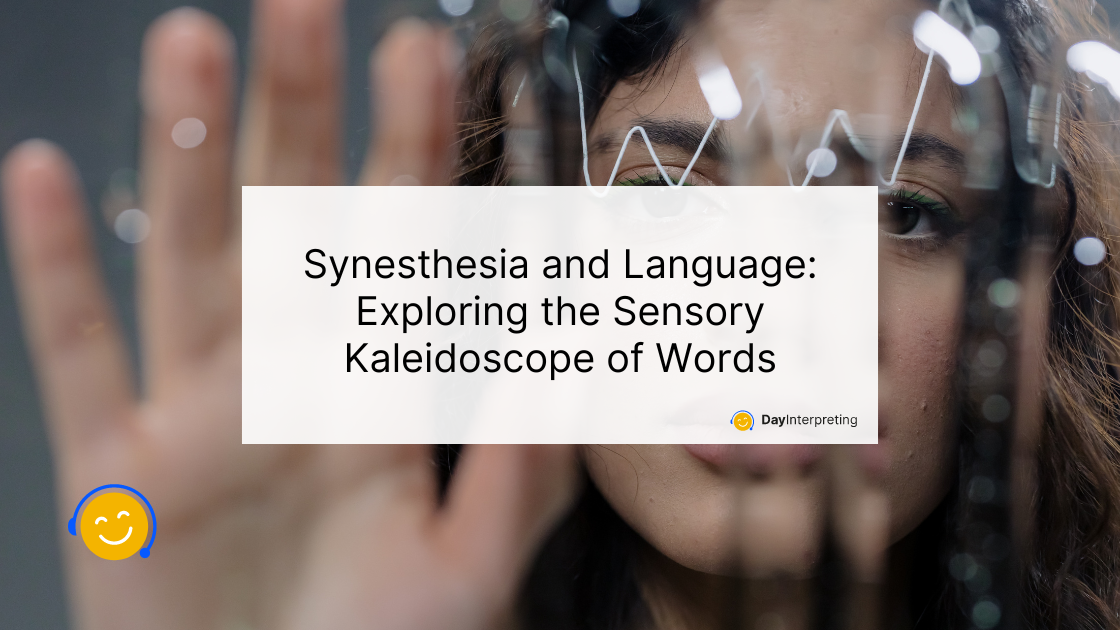Imagine a world where every word you hear paints a vivid picture, evokes a distinct taste, or triggers a unique sensation. Welcome to the fascinating realm of synesthesia, a phenomenon that blurs the lines between the senses and transforms language into a sensory kaleidoscope. In this in-depth exploration, we’ll delve deeper into synesthesia and language as well as its relevance in the realm of interpreting.
What is Synesthesia?
Synesthesia is like having a secret code in your brain that merges sensory experiences. It’s a neurological condition where stimulation of one sensory pathway leads to automatic experiences in another pathway. This can manifest in various forms: hearing colors, tasting words, feeling textures from sounds—the possibilities are as diverse as the human imagination.
The Richness of Synesthesia and Language
For synesthetes, everyday encounters with language are anything but ordinary. A simple word like “music” might evoke a symphony of colors, textures, and even smells. This heightened sensory perception adds depth and meaning to their linguistic encounters, turning mundane conversations into multisensory adventures.
Exploring the Senses through Language
Language, by its very nature, engages multiple senses. Our brains light up with activity across various sensory regions when we speak or listen. This phenomenon explains why certain words evoke strong emotional responses or vivid mental images. Synesthesia amplifies this experience, amplifying the sensory dimensions of language.
The Colors of Words
One of the most well-known forms of synesthesia is associating colors with words or sounds. For instance, the word “joy” might shimmer in hues of yellow and gold, while “melancholy” might be draped in shades of blue. These color associations are deeply personal to each synesthete, creating a unique palette of linguistic sensations.
Synesthesia and Emotional Resonance
Beyond colors, synesthesia can imbue words with emotional tones. A synesthete might describe a word as “warm” or “cool,” reflecting not just its literal meaning but also the emotional impact it carries. This emotional resonance adds a layer of richness to communication, allowing for deeper connections and understanding.
Synesthesia and Interpretation
In the realm of interpreting, synesthesia can be a double-edged sword. On one hand, it offers interpreters a heightened sensitivity to language’s nuances and emotional undertones. This can lead to more accurate and empathetic interpretations, especially in contexts where cultural nuances play a significant role. On the other hand, managing the flood of sensory information can be challenging, requiring interpreters to strike a delicate balance between sensory perception and linguistic accuracy.
Harnessing Synesthesia in Interpretation
Synesthesia can serve as a valuable asset for interpreters willing to harness its power. By tapping into the sensory dimensions of language, interpreters can convey words and the accompanying emotions, imagery, and cultural nuances. This holistic approach to interpretation creates a more immersive experience for both speakers and listeners, fostering deeper connections and enhancing communication.
Synesthesia in Everyday Language
Even for non-synesthetes, understanding synesthesia sheds light on the rich tapestry of language. Paying attention to the sensory aspects of words can make communication more engaging and memorable. It encourages us to choose words that convey information and evoke sensory experiences, making our messages more impactful and resonant.
Synesthesia is often associated with creativity, as it blurs the boundaries between sensory modalities. Artists, musicians, and writers with synesthesia often draw inspiration from their sensory experiences, infusing their creations with a unique blend of colors, sounds, and emotions. This creative synergy between senses fuels innovation and artistic expression.
Final Thoughts: Embracing the Synesthetic Journey
Synesthesia invites us to explore the intricate connections between our senses and language. It challenges us to perceive communication as a means of conveying information and a multisensory experience rich in colors, tastes, textures, and emotions. As interpreters, embracing the synesthetic journey opens doors to deeper understanding, cultural empathy, and more vibrant interpretations that transcend words alone.
So, let your senses come alive next time you encounter a word. Dive into the sensory kaleidoscope of language and discover the magic of synesthesia woven into every syllable and sentence.





0 Comments